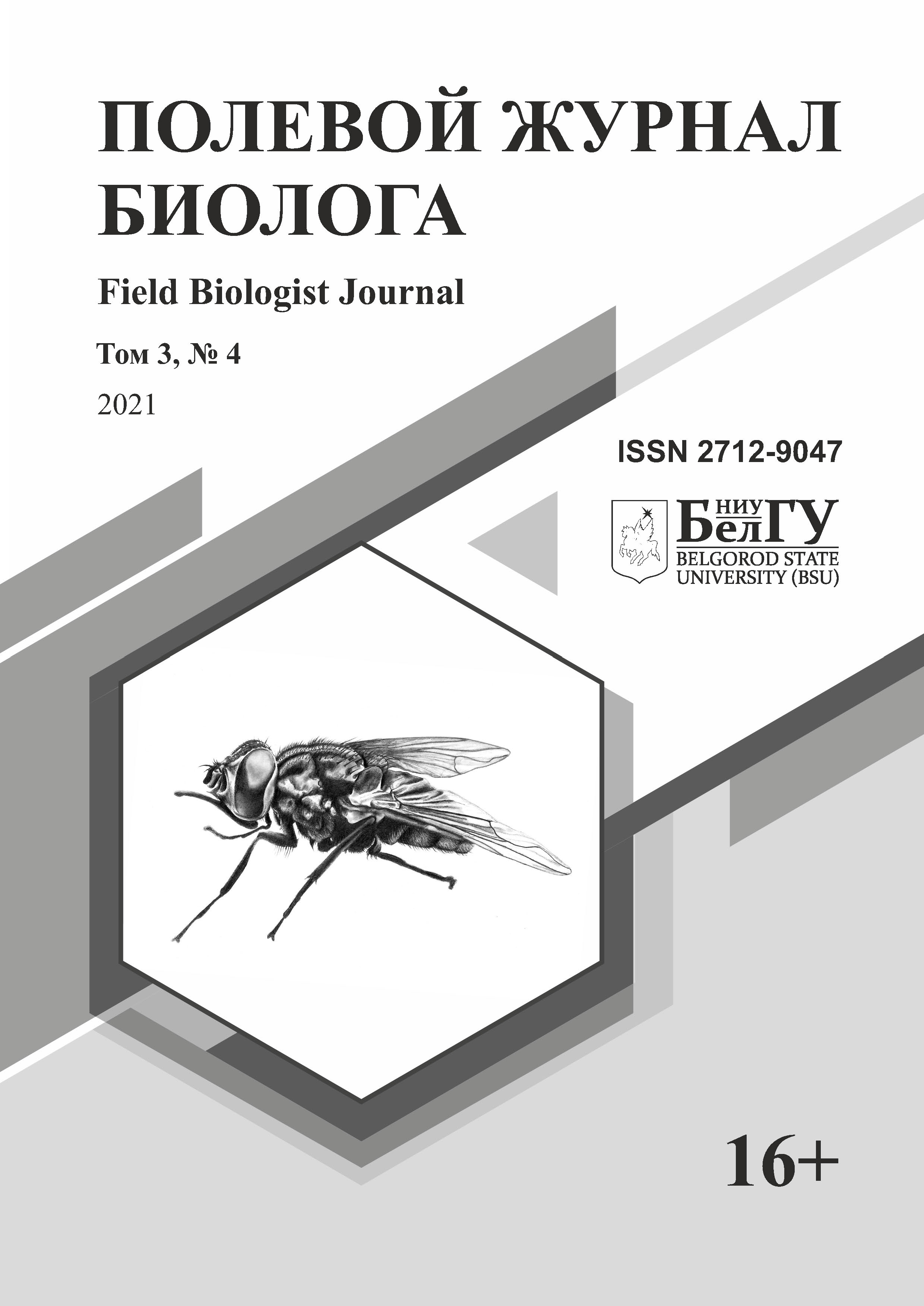Об эффективном использовании мобильных автоматических светоловушек для исследований чешуекрылых (Lepidoptera), привлекаемых УФ-излучением, в горных условиях
DOI:
https://doi.org/10.52575/2712-9047-2021-3-4-339-349Ключевые слова:
методы сбора материала, УФ-излучение, ночные бабочкиАннотация
Использование автоматических светоловушек на базе источников УФ-излучения для сбора материала в настоящее время является общепринятым трендом полевых исследований насекомых с ночной активностью. Несмотря на широкое применение светоловушек, методики их использования остаются слабо разработанными. Целью данного исследования является сравнение различных методов использования светоловушек с разными типами УФ-излучения в полевых условиях и выработка наиболее оптимального метода их использования. Исследование проводилось в трех локалитетах в Киргизии, каждая стадия эксперимента включала 4 наблюдения (использование одной мощной светоловушки, затем – одной мощной и двух слабых светоловушек с одинаковой длиной волны УФ-излучения, затем – одной мощной и двух слабых светоловушек с разной длиной волны УФ-излучения; в последнюю ночь использовалось до 5 разных светоловушек). Показано, что наиболее эффективным как в качественном, так и в количественном отношении методом сбора материала с помощью светоловушек является использование одной светоловушки с УФ-источником большой мощности и расположенными на границах ее светового пятна светоловушками с УФ-источниками малой мощности и разной длины волны (разного типа). Наименьшим эффективным числом мобильных автоматических светоловушек является три, одна из которых – большой мощности, две другие – малой мощности, разной длины волны. Полученные результаты позволяют планировать и производить более эффективное использование светоловушек в полевых исследованиях.
Скачивания
Библиографические ссылки
Dubatolov V.V. 2012. Light trap usage for moth population studies (Insecta, Lepidoptera). Euroasian Entomological Journal, 11 (2): 186–188 (in Russian).
Pachkin A.A., Popov I.B., Kremneva O.Yu., Zelenskiy R.A. 2019. The use of light traps for capturing insects in a sunflower agrocenosiss. Achievements of Science and Technology in Agro-Industrial Complex, 33 (12): 73–76 (in Russian). DOI: 10.24411/0235-2451-2019-11215
Abbas M., Ramzan M., Hussain N., Ghaffar A., Hussain K., Abbas S., Raza A. 2019. Role of light traps in attracting, killing and biodiversity studies of insect pests in Thal. Pakistan Journal of Agricultural Research, 32 (4): 684–690. DOI: 10.17582/journal.pjar/2019/32.4.684.690
Bjerge K., Nielsen J.B., Sepstrup M.V., Helsing-Nielsen F., Høye T.T. 2020. An automated light trap to monitor moths (Lepidoptera) using computer vision-based tracking and deep learning. Sensors, 21 (2): 343. DOI: 10.1101/2020.03.18.996447
Cohnstaedt L., Gillen J.I., Munstermann L.E. 2008. Light-emitting diode technology improves insect trapping. Journal of American Mosquito Control Association, 24 (2): 331–334. DOI: 10.2987/5619.1
Costa-Neta B.M., Lima-Neto A.R., Silva A.A., Bruto J.M., Aguiar J.V.C., Ponte I.S., Silva F.S. 2018. Centers for disease control-type light traps equipped with high-intensity light-emitting diodes as light sources for monitoring Anopheles mosquitoes. Acta Tropica, 183: 61–63. DOI: 10.1016/j.actatropica.2018.04.013
Faria P., Nogueira T., Ferreira A., Carlos C., Rosado L. 2021. AI-powered mobile image acquisition of vineyard insect traps with automatic quality and adequacy assessment. Agronomy, 11: 731. DOI: 10.3390/agronomy11040731
Fry R., Waring P. 1996. A guide to moth traps and their use. The Amateur Entomologist, 24: 1–60.
Gaglio G., Napoli E., Falsone L., Giannetto S., Brianti E. 2017. Field evaluation of a new light trap for phlebotomine sand flies. Acta Tropica, 174: 114–117. DOI: 10.1016/j.actatropica.2017.07.011
Heath J. 1976. Insect light traps. The Amateur Entomologists’ Society leaflet, 33: 1–16.
Infusino M., Brehm G., Di Marco C., Scalercio S. 2017. Assessing the efficiency of UV LEDs as light sources for sampling the diversity of macro-moths (Lepidoptera). European Journal of Entomology, 114: 25–33. DOI: 10.14411/eje.2017.004
Jonason D., Franzén M., Ranius T. 2014. Surveying moths using light traps: effects of weather and time of year. PLOS One, 9 (3): e92453. DOI: 10.1371/journal.pone.0092453
Kammar V., Rani A.T., Kumar K., Chakravarthy A.K. 2020. Light trap: a dynamic tool for data analysis, documenting, and monitoring insect populations and diversity. Chakravarthy A.K. (Ed.) Innovative Pest Management Approaches for the 21st Century. Singapore, Springer Nature: 137–163. DOI: 10.1007/978-981-15-0794-6_8
Korb S.K. 2018. Automatic autonomous light traps and their usage for the quantitative accounting on example of hawkmoths of Kyrgyzstan (Lepidoptera: Sphingidae). Nature Conservation Research, 3 (3): 80–85. DOI: 10.24189/ncr.2018.017
Morton R., Tuart L.D., Wardhaugh K.G. 1981. The analysis and standardisation of light-trap catches of Heliothis armigera (Hübner) and H. punctiger Wallengren (Lepidoptera: Noctuidae). Bulletin of Entomological Research, 71: 207–225. DOI: 10.1017/s0007485300008245
Ricklefs R.E. 1975. Seasonal occurrence of night-flying insects on Barro Colorado Island, Panama Canal Zone. Journal of New York Entomological Society, 83: 19–32.
Sheikh A.H., Thomas M., Bhandari R., Bunkar K. 2016. Light trap and insect sampling: an overview. International Journal of Current Research, 8 (11): 40868–40873.
Shimoda M., Honda K.-i. 2013. Insect reactions to light and its applications to pest management. Applied entomology and zoology, 48 (4): 413–421. DOI: 10.1007/s13355-013-0219-x
Solsoloy A.D., Begonia M., Tolentino J., Castillo A. 2013. Enhancing the utilization of the light trapping technology for insect pest management of major crops in selected provinces of Region 1 [Ilocos Region] Philippines [2010]. Journal of International Society for Southeast Asian Agricultural Sciences, 16 (1): 133–134.
Thomas A.W. 1996. Light-trap catches of moths within and above the canopy of a northeastern forest. Journal of the Lepidopterists Society, 50: 21–45.
Yao Q., Feng J., Tang J., Xu W.-g., Zhu X.-h., Yang B.-j., Lü J., Xie Y.-z., Wu S.-z., Kuai N.-i., Wang L.-j. 2020. Development of an automatic monitoring system for rice light-trap pests based on machine vision. Journal of Integrative Agriculture, 19 (10): 2500–2513. DOI: 10.1016/s2095-3119(20)63168-9
Просмотров аннотации: 261
Поделиться
Опубликован
Как цитировать
Выпуск
Раздел
Copyright (c) 2021 Станислав Константинович Корб

Это произведение доступно по лицензии Creative Commons «Attribution» («Атрибуция») 4.0 Всемирная.



